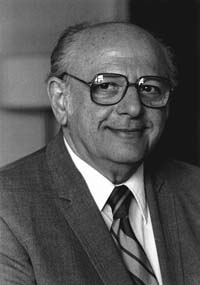George Gaber
by Rebecca Kite
Distinguished as both a performer and teacher, George Gaber's lifetime achievements include work with many of the most important orchestras, composers and conductors of the twentieth century. His dedication to teaching and standard of excellence live on in his numerous students who are involved in all areas of music throughout the world.
 Gaber became a musician in the exciting, music-filled atmosphere of New York in the 1930s. He studied snare drum with David Gusikoff, timpani with Karl Glassman and keyboard instruments with Joe Castka. He also studied at Juilliard and the Manhattan School of Music and did graduate study at Cooper Union in Architecture Design.
Gaber became a musician in the exciting, music-filled atmosphere of New York in the 1930s. He studied snare drum with David Gusikoff, timpani with Karl Glassman and keyboard instruments with Joe Castka. He also studied at Juilliard and the Manhattan School of Music and did graduate study at Cooper Union in Architecture Design.
He started professionally with dance bands and Latin groups. Gaber toured the U.S. with the Ballet Russe De Monte Carlo Orchestra from 1937-39 and was timpanist of the Pittsburgh Symphony with Fritz Reiner as conductor from 1939-1943. In 1940 Gaber was chosen by Leopold Stokowski to be timpanist with the All American Youth Orchestra (AAYO) for its South American tour.
Cloyd Duff, who played percussion with the AAYO during that time, recalls, "George is one of a kind. I have always admired his teaching and his performance. He has fantastic timpani pedaling technique, a thorough knowledge of the classics and show business, and a vast knowledge of all percussion instruments - especially ethnic instruments. He is sincere and generous as a teacher, and over the years I have often suggested that my students study with him."
Gaber's work in New York throughout the 1940s and '50s included performances and recordings with symphony, jazz, modern dance groups, opera, radio, film and TV productions. He worked with conductors and composers Gian Carlo Menotti, Duke Ellington, Lukas Foss, Paul Whiteman, Noah Greenberg, Erich Leinsdorf, Otto Klemperer and Heitor Villa Lobos. He worked closely with and premiered several works by Darius Milhaud, Igor Stravinsky, Paul Hindemith and Bela Bartok. He played with the Los Angeles, Israel Philharmonic, Baltimore, Minnesota and New York orchestras under the batons of Leonard Bernstein, Zubin Mehta, Sergui Comissiona, Fritz Reiner, Leopold Stokowski and Walter Susskind.
In 1960 Gaber moved to Indiana University, where he focused on teaching and building a university percussion curriculum and department. "I had a taste of teaching in New York, which stimulated my dream about what a percussion curriculum could be," he says. "The music that students studied at school didn't reflect what I was performing as a professional. I wanted to include Baroque music, Renaissance music, pop music, jazz, ethnic percussion and drumset. In 1960 these instruments and styles of music were not played by college percussionists. At Indiana, I was free to pursue my dream and develop this type of study."
Gaber brought his extensive experience in orchestral, studio and freelance percussion to his teaching. He built a percussion department that, by the mid- 1970s, had a reputation for excellence that drew students from around the world. He has lectured and served as an adjudicator at music schools and festivals in the U.S. and around the world including Canada, Costa Rica, Australia, Mexico, Brazil, Israel, Japan and China, including the Aspen, Colorado and Banff, Canada Music Festivals. The Secretary of UNESCO in Paris recommended him as advisor and participant for the "Percussion of the World" Festival of Iran in 1969.
In addition to teaching at Indiana University, Gaber continued to premiere and perform new music, working with composers Dave Brubeck, David Baker, Lukas Foss, Donald Erb, Fred Fox and John Eaton.
Gaber's accomplishments as an educator are reflected by the activities of his students who are employed in symphonies, colleges and universities, recording studios and in the music business around the world. The most well-known of these include Cleveland Orchestra principal percussionist Richard Weiner, jazz drummer Peter Erskine and rock drummer Kenny Aronoff.
Dr. Kay Stonefelt says of Gaber, "When he took the position at IU in 1960, he was one of the most knowledgeable and influential people in the world of percussion. He had worked with Stravinsky, Milhaud, Bartok and Hindemith. Gaber was a link to the source - a connection with the composers of the literature we perform as percussionists."
Perhaps Gaber's greatest contribution to percussion is his dedication to excellence. Dr. Stuart Marrs says, "Gaber instilled in his students an inextinguishable drive for the pursuit of excellence. In turn, these students have passed this legacy on to their own students."
Gaber also brought professionalism and thoroughness of preparation to each performance setting. Dr. Norman Weinberg recalls, "The most valuable thing I learned from George was, no matter what it takes, make your part. I'll never forget my first percussion ensemble rehearsal at IU. I had a part with an insanely fast switch from timpani to claves. The timpani part was too fast to do with one stick and I didn't make the switch the first time. Gaber stopped and pointed out that I missed it. We did it a second time and I still couldn't make the switch. The third time he stopped and said: 'Make the part. That's what separates the men from the boys.' I spent the next week figuring out how to make this part work. Finally I built a stand so I could suspend one clave and play the timpani part holding both a timpani stick and the other clave in my left hand. When I nailed the part at the second rehearsal, Gaber just looked at me and smiled."